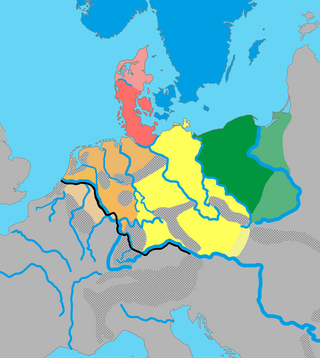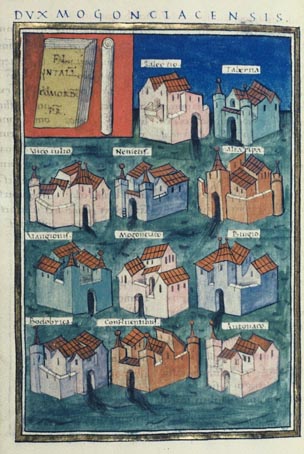History
According to Velleius Paterculus, in 4 AD, the emperor Tiberius crossed the Rhine, first attacking a tribe which commentators interpret variously as the Cananefates or Chamavi, both being in the area of the modern Netherlands, then the Chattuari, and then the Bructeri between Ems and Lippe, somewhere to the north of the modern Ruhr district in Germany. This implies that the Chattuari lived somewhere in the west of Westphalia. [2]
Strabo mentions the Chattuari as one of the non-nomadic northern Germanic tribes in a group along with the Cherusci, the Chatti, and the Gamabrivii. (He also contrasted with other non nomadic tribes supposedly near the Ocean, the Sugambri, the "Chaubi", the Bructeri, and the Cimbri, "and also the Cauci, the Caülci, the Campsiani".) Strabo also notes them as one of the tribes who allied under the Cherusci and were made poor after being defeated by Germanicus. They apparently appeared at his triumph in 17 AD along with the Caülci, Campsani, Bructeri, Usipi, Cherusci, Chatti, Landi, and Tubattii.
There is no consensus on any connection between the Chattuarii and either the similar-sounding Chatti or, less likely, the Chasuarii, who both lived in a similar region of Germany, and are also mentioned in Roman era texts.
The Chattuari appear again in the historical record in the 4th century, living on the Rhine amongst the first tribes to be known as Franks. Ammianus Marcellinus reports that Emperor Julian, crossed the Rhine border from Xanten and...
...entered the district belonging to a Frank tribe, called the Attuarii, men of a turbulent character, who at that very moment were licentiously plundering the districts of Gaul. He attacked them unexpectedly while they were apprehensive of no hostile measures, but were reposing in fancied security, relying on the ruggedness and difficulty of the roads which led into their country, and which no prince within their recollection had ever penetrated. [3]
Some of them (laeti) were also settled in France pagus attuariorum (French; Atuyer, comprising Oscheret at that time) south of Langres in the 3rd century.
Under the Franks, the name of the Chattuari was used for what became two early medieval gaus on either side of the Rhine, north of the Ripuarian Franks, whose capital was in Cologne. On the eastern side, they were near the Ruhr river, and across the Rhine they settled near the Niers river, between the Maas and the Rhine, where the Romans had much earlier settled the Germanic Cugerni. [1] This western gau (Dutch: Hettergouw, German: Hattuarien) is mentioned in the Treaty of Meerssen, in the year 870 AD. [4]
The Chattuarii may also appear in the poem Beowulf as "Hetwaras" where they appear to form a league together with the Hugas (who may be the Chauci) and the Frisians to fight against a Geatish raiding force from Denmark. The Geats are defeated and their king Hygelac is killed, Beowulf alone escaping. According to Widsith, the Hætwera were ruled by Hun.

The Suebi or Suebians were a large group of Germanic peoples originally from the Elbe river region in what is now Germany and the Czech Republic. In the early Roman era they included many peoples with their own names such as the Marcomanni, Quadi, Hermunduri, Semnones, and Lombards. New groupings formed later, such as the Alamanni and Bavarians, and two kingdoms in the Migration Period were simply referred to as Suebian.

The Chatti were an ancient Germanic tribe whose homeland was near the upper Weser (Visurgis), whose name might mean "pursuers". They lived in central and northern Hesse and southern Lower Saxony, along the upper reaches of that river and in the valleys and mountains of the Eder and Fulda regions, a district approximately corresponding to Hesse-Kassel, though probably somewhat more extensive. They settled within the region in the first century BC. According to Tacitus, the Batavians and Cananefates of his time, tribes living within the Roman Empire, were descended from part of the Chatti, who left their homeland after an internal quarrel drove them out, to take up new lands at the mouth of the Rhine.

The Cherusci were a Germanic tribe that inhabited parts of the plains and forests of northwestern Germany in the area of the Weser River and present-day Hanover during the first centuries BC and AD. Roman sources reported they considered themselves kin with other Irmino tribes and claimed common descent from an ancestor called Mannus. During the early Roman Empire under Augustus, the Cherusci first served as allies of Rome and sent sons of their chieftains to receive Roman education and serve in the Roman army as auxiliaries. The Cherusci leader Arminius led a confederation of tribes in the ambush that destroyed three Roman legions in the Teutoburg Forest in AD 9. He was subsequently kept from further damaging Rome by disputes with the Marcomanni and reprisal attacks led by Germanicus. After rebel Cherusci killed Arminius in AD 21, infighting among the royal family led to the highly Romanized line of his brother Flavus coming to power. Following their defeat by the Chatti around AD 88, the Cherusci do not appear in further accounts of the German tribes, apparently being absorbed into the late classical groups such as the Saxons, Thuringians, Franks, Bavarians, and Allemanni.

The Ampsivarii, sometimes referenced by modern writers as Ampsivari, were a Germanic tribe mentioned by ancient authors.

The Bructeri were a Germanic tribe in Roman imperial times, located in northwestern Germany, in present-day North Rhine-Westphalia. Their territory included both sides of the upper Ems and Lippe rivers. At its greatest extent, their territory apparently stretched between the vicinities of the Rhine in the west and the Teutoburg Forest and Weser river in the east. In late Roman times they moved south to settle upon the east bank of the Rhine facing Cologne, an area later associated with the Ripuarian Franks.

The Usipetes or Usipii were an ancient tribe who moved into the area on the right bank of the lower Rhine in the first century BC, putting them in contact with Gaul and the Roman empire. They are known first from the surviving works of ancient authors such as Julius Caesar and Tacitus. They appear to have moved position several times before disappearing from the historical record.

The Istvaeones were a Germanic group of tribes living near the banks of the Rhine during the Roman Empire which reportedly shared a common culture and origin. The Istaevones were contrasted to neighbouring groups, the Ingaevones on the North Sea coast, and the Herminones, living inland of these groups.

Ripuarian or Rhineland Franks were one of the two main groupings of early Frankish people, and specifically it was the name eventually applied to the tribes who settled in the old Roman territory of the Ubii, with its capital at Cologne on the Rhine river in modern Germany. Their western neighbours were the Salii, or "Salian Franks", who were named already in late Roman records, and settled with imperial permission within the Roman Empire in what is today the southern part of the Netherlands, and Belgium, and later expanded their influence into the northern part of France north of the Loire river, creating the Frankish empire of Francia.

The Sicambri, also known as the Sugambri or Sicambrians, were a Germanic people who during Roman times lived on the east bank of the river Rhine, in what is now Germany, near the border with the Netherlands. They were first reported by Julius Caesar, who described them as Germanic (Germani), though he did not necessarily define this in terms of language.

The Hermunduri, Hermanduri, Hermunduli, Hermonduri, or Hermonduli were an ancient Germanic tribe, who occupied an inland area near the source of the Elbe river, around what is now Bohemia from the first to the third century, though they have also been speculatively associate with Thuringia further north. According to an old proposal based on the similarity of the names, the Thuringii may have been the descendants of the Hermunduri. At times, they apparently moved to the Danube frontier with Rome. Claudius Ptolemy mentions neither tribe in his geography but instead the Teuriochaemae, who may also be connected to both.

This is a chronology of warfare between the Romans and various Germanic peoples. The nature of these wars varied through time between Roman conquest, Germanic uprisings, later Germanic invasions of the Western Roman Empire that started in the late second century BC, and more. The series of conflicts was one factor which led to the ultimate downfall of the Western Roman Empire in particular and ancient Rome in general in 476.

The Chamavi, Chamãves or Chamaboe (Χαμαβοί) were a Germanic tribe of Roman imperial times whose name survived into the Early Middle Ages. They first appear under that name in the 1st century AD Germania of Tacitus as a Germanic tribe that lived to the north of the Lower Rhine. Their name probably survives in the region today called Hamaland, which is in the Gelderland province of the Netherlands, between the IJssel and Ems rivers.

The Chasuarii were an ancient Germanic tribe known from the reports of authors writing in the time of the Roman Empire. They lived somewhere to the east and north of the Rhine, near the modern river Hase, which feeds into the Ems. This means they lived near modern Osnabrück.

The Vangiones appear first in history as an ancient Germanic tribe of unknown provenance. They threw in their lot with Ariovistus in his bid of 58 BC to invade Gaul through the Doubs river valley and lost to Julius Caesar in a battle probably near Belfort. After some Celts evacuated the region in fear of the Suebi, the Vangiones, who had made a Roman peace, were allowed to settle among the Mediomatrici in northern Alsace.. They gradually assumed control of the Celtic city of Burbetomagus, later Worms.

The Angrivarii were a Germanic people of the early Roman Empire, who lived in what is now northwest Germany near the middle of the Weser river. They were mentioned by the Roman authors Tacitus and Ptolemy.

The Dulgubnii are a Germanic tribe mentioned in Tacitus' Germania as living in what is today northwest Germany. Tacitus describes them being to the north of the Angrivarii and Chamavi, and as having moved from the north into the area once belonging to the Bructeri, between Ems, Lippe, and Weser. In this same area as the Dulgubnii, north of the Chamavi and Angrivarii, were the Chasuarii, and north of these, on the North Sea coast, where the Chauci. The Chasuarii's name is thought to derive from the River Hase which feeds into the middle of the Ems from the east, just northwest of the area associated with the Angrivarii, on the Weser. So from Tacitus, it appears that the Dulgubnii probably lived near the Weser.
The Tubantes were a Germanic tribe, living in the eastern part of the Netherlands, north of the Rhine river. They are often equated to the Tuihanti, who are known from two inscriptions found near Hadrian's Wall. The modern name Twente derives from the word Tuihanti.

The Tencteri or Tenchteri or Tenctheri were an ancient tribe, who moved into the area on the right bank of the lower Rhine in the 1st century BC. They are known first from the surviving works of ancient authors such as Julius Caesar and Tacitus. In December 2015, archaeologists believed they found remains of the Tencteri in The Netherlands.
The Battle of the Angrivarian Wall was fought near Porta Westfalica, Germany in 16 AD between the Roman general Germanicus and an alliance of Germanic tribes commanded by Arminius. This battle followed immediately after the Battle of Idistaviso, and was supposedly sparked by Germanic outrage over the trophy erected on that prior battlefield by the Romans.








